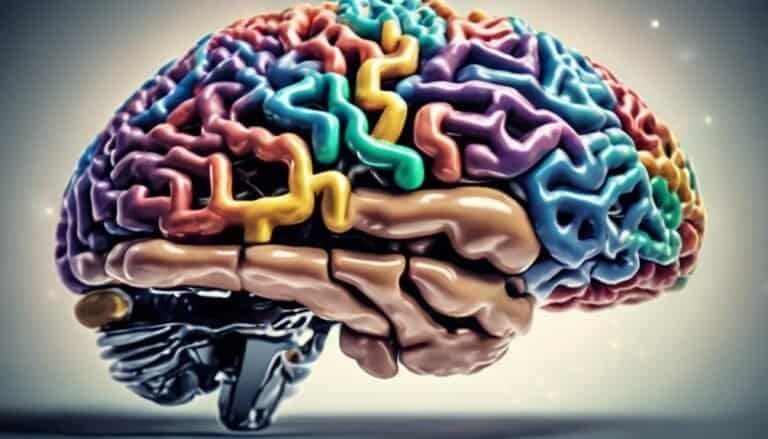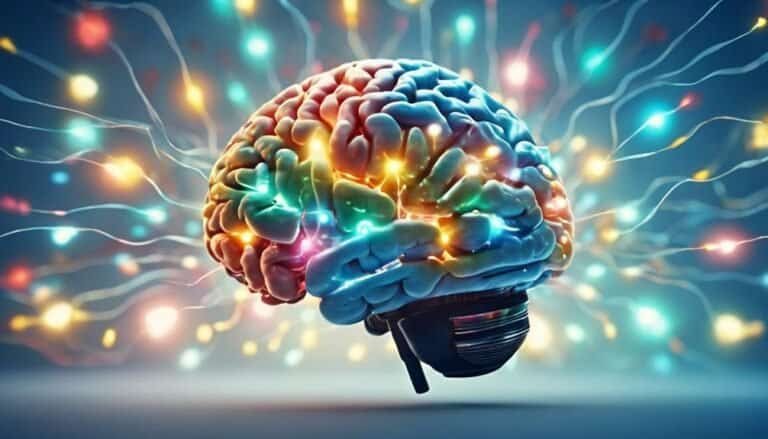Brain Stimulation for Creativity
You've probably heard the saying, 'Necessity is the mother of invention.' But what if there was a way to tap into your creativity more intentionally?
Brain stimulation techniques have been gaining attention for their potential to enhance creative thinking. Imagine being able to unlock new levels of innovation and problem-solving skills by simply stimulating specific areas of your brain. This intriguing field holds promise for not just artists and musicians but for anyone looking to boost their creative abilities.
But how exactly does it work, and what are the implications of tinkering with our brain's natural processes?
Key Takeaways
- Brain stimulation techniques like TMS and tDCS enhance neural pathways for creativity.
- Neuroplasticity enables brain changes that boost creative thinking and problem-solving abilities.
- Understanding individual responses and risks associated with brain stimulation is crucial for creativity enhancement.
- Ongoing research aims to optimize stimulation parameters and explore new targets for enhancing creative processes.
Understanding Brain Stimulation Techniques
Exploring the various brain stimulation techniques can provide valuable insights into how creativity can be enhanced through scientific methods. Cognitive enhancement, a key aspect of brain function, is deeply intertwined with creative potential and neural activity. By understanding how different brain stimulation methods affect neural pathways involved in creativity, researchers can unravel the intricate mechanisms that underlie creative thinking.
Transcranial magnetic stimulation (TMS) is one such technique that has garnered significant attention in the realm of cognitive enhancement. Through the targeted application of magnetic fields to specific regions of the brain, TMS can modulate neural activity and potentially boost creative potential. By fine-tuning the excitability of certain brain areas implicated in creative processes, TMS offers a promising avenue for enhancing cognitive functions related to creativity.
Studying the effects of TMS on brain function during creative tasks can provide valuable insights into the intricate interplay between neural circuits and creative thinking processes. This analytical approach allows researchers to decipher the neural mechanisms that govern creativity and pave the way for novel interventions aimed at unlocking the full creative potential of the human mind.
Effects of TMS on Creativity
To understand the impact of transcranial magnetic stimulation (TMS) on creativity, it is essential to examine how this technique modulates neural activity in brain regions associated with creative processes. TMS is a non-invasive brain stimulation method that uses magnetic fields to induce electrical currents in specific areas of the brain. By targeting regions linked to creativity, TMS can influence cognitive enhancement and neural modulation, thus affecting creative thinking and idea generation.
| Effects of TMS on Creativity | |
|---|---|
| Cognitive Enhancement | Neural Modulation |
| Increases divergent thinking | Modulates activity in the dorsolateral prefrontal cortex |
| Enhances problem-solving skills | Influences connectivity within the default mode network |
| Boosts creative idea generation | Regulates activity in the anterior cingulate cortex |
Through its ability to enhance cognitive functions and modulate neural pathways, TMS offers a promising avenue for exploring creative enhancement. By understanding how TMS affects brain activity related to creativity, researchers can further optimize its application to foster inventive thinking processes.
Exploring Tdcs for Creative Enhancement
When considering Tdcs for creative enhancement, it's vital to understand the basics of this brain stimulation technique.
By exploring the benefits and potential risks associated with Tdcs, you can make informed decisions regarding its application for creativity.
It's crucial to weigh these factors carefully to optimize the effectiveness of Tdcs in enhancing creative processes.
Tdcs Basics for Creativity
How does transcranial direct current stimulation (tDCS) impact creativity enhancement? tDCS involves applying low electrical currents to specific areas of the brain through electrodes placed on the scalp. By modulating brain function, tDCS can enhance cognitive processes related to creativity. The intensity of the current plays a crucial role in determining the effects on brain function. Here is a table summarizing the key aspects of tDCS for creative enhancement:
| Aspect | Description |
|---|---|
| Electrode Placement | Determines targeted brain area |
| Cognitive Enhancement | Improves creative thinking |
| Current Intensity | Influences stimulation effects |
| Brain Function | Altered to boost creativity |
Benefits of Brain Stimulation
Building upon the foundational knowledge of tDCS basics for creativity, exploring the benefits of brain stimulation specifically in the context of creative enhancement sheds light on the potential cognitive advantages that can be harnessed through targeted neural modulation.
When considering brain stimulation for creative enhancement, one can expect the following:
- Cognitive Enhancement: tDCS has the potential to enhance cognitive functions related to creativity by modulating neural activity in specific brain regions.
- Optimization of Brain Waves: Brain stimulation techniques can help optimize brain waves, facilitating a state of mind conducive to creative thinking.
- Neurological Benefits for Mental Performance: By influencing neural pathways, brain stimulation may offer neurological benefits that enhance overall mental performance.
Risks and Considerations
To explore the risks and considerations associated with using tDCS for creative enhancement, it's crucial to delve into the potential implications of neural modulation on cognitive processes. When considering long-term effects, precautions must be taken due to the lack of extensive research on the lasting impact of tDCS on creativity.
Individual differences play a significant role in how individuals respond to tDCS, as some may experience side effects such as headaches, skin irritation, or mood changes. It's essential to acknowledge these variations and monitor closely for any adverse reactions, adjusting stimulation parameters accordingly.
As with any cognitive enhancement technique, careful assessment and personalized approaches are necessary to mitigate potential risks and maximize the benefits of tDCS for creative enhancement.
Neuroplasticity and Creative Thinking
When exploring neuroplasticity and creative thinking, your brain undergoes changes that facilitate creativity and enhance innovative thinking.
These alterations in brain structure and function are crucial for fostering novel ideas and unique perspectives.
Understanding how neuroplasticity influences creative cognition can provide valuable insights into optimizing creative processes.
Brain Changes for Creativity
Neuroplasticity plays a fundamental role in shaping the brain's ability to generate creative thoughts and ideas.
Brain plasticity allows for the formation of new neural connections, enabling novel ways of thinking and problem-solving.
Increased creativity enhancement is observed when the brain undergoes changes that facilitate divergent thinking and idea generation.
Research suggests that individuals with enhanced brain plasticity tend to exhibit improved cognitive performance, leading to more innovative solutions and artistic expressions.
Understanding how neuroplasticity influences creative thinking can offer insights into how to optimize brain function for enhanced creativity and problem-solving skills.
Enhancing Innovative Thinking
Enhancing innovative thinking involves harnessing the brain's natural ability to reorganize itself for optimal creative output. Innovation techniques and brainstorming methods play a crucial role in stimulating creative processes.
By adopting a creative mindset and cultivating cognitive flexibility, individuals can enhance their capacity for innovative thinking. Engaging in activities that challenge conventional thought patterns and encourage out-of-the-box solutions can help strengthen neural pathways associated with creativity.
Additionally, practicing divergent thinking, where multiple solutions are explored for a given problem, can further boost creative cognitive processes. By actively seeking new perspectives and embracing uncertainty, individuals can train their brains to think innovatively and adaptively, fostering a mindset conducive to creative breakthroughs.
Enhancing Problem-Solving Skills
Utilizing brain stimulation techniques can significantly boost problem-solving skills by enhancing cognitive flexibility and neural connectivity. When aiming to improve your problem-solving abilities through brain stimulation, consider the following key points:
- Increased Cognitive Flexibility:
Brain stimulation has been shown to enhance cognitive flexibility, allowing you to approach problems from various angles and adapt your thinking strategies to different situations efficiently.
- Enhanced Neural Connectivity:
By stimulating specific brain regions associated with problem-solving, such as the prefrontal cortex and hippocampus, you can strengthen neural connectivity within these areas. This enhanced connectivity facilitates smoother information processing and retrieval, crucial for tackling complex problem-solving tasks effectively.
- Improved Decision-Making Skills:
Brain stimulation techniques can also aid in improving decision-making processes by enhancing the speed and accuracy of your cognitive responses. This can lead to more efficient problem-solving outcomes and a greater ability to navigate challenging scenarios with confidence.
Incorporating brain stimulation methods targeted towards enhancing problem-solving skills can offer significant benefits in boosting your cognitive performance and overall problem-solving capabilities.
Risks and Safety Considerations
To ensure the safe and effective application of brain stimulation techniques for enhancing problem-solving skills, it's crucial to carefully consider the associated risks and safety considerations. Safety precautions must be strictly adhered to when engaging in brain stimulation procedures. Ethical concerns surrounding the use of these techniques should also be at the forefront of any discussion.
Potential side effects, such as headaches, scalp discomfort, or mild tingling sensations, may occur during or after stimulation sessions. It's essential to monitor these effects closely and adjust the stimulation intensity accordingly to prevent any adverse outcomes. Furthermore, the long-term effects of repeated brain stimulation for creativity enhancement are still not fully understood, highlighting the need for ongoing research in this area.
It's imperative to prioritize participant safety and well-being by implementing comprehensive safety protocols and closely monitoring any potential risks that may arise from the use of brain stimulation techniques in the pursuit of enhancing problem-solving skills.
Potential Applications in Art and Music
Brain stimulation techniques hold promise for unlocking new avenues of creativity in the realms of art and music. When considering the potential applications in these fields, several key points emerge:
- Art Therapy: Brain stimulation could be utilized in art therapy sessions to enhance creative expression in individuals facing mental health challenges. By modulating specific brain regions associated with creativity, such as the prefrontal cortex, individuals may experience improved cognitive function and emotional well-being during the artistic process.
- Cognitive Enhancement: In the domain of music composition, brain stimulation techniques hold potential for enhancing cognitive functions crucial for creative work. By targeting areas involved in auditory processing and creative ideation, such as the temporal and frontal lobes, neural modulation could potentially augment the compositional abilities of musicians and composers.
- Neural Modulation: By precisely modulating neural activity, brain stimulation techniques offer a targeted approach to enhancing creative processes in both art and music. The ability to fine-tune brain activity patterns may lead to breakthroughs in artistic expression and musical innovation.
Future Research Directions
For future research directions in brain stimulation for creativity, exploring novel neural targets and optimizing stimulation parameters are key priorities. Cognitive enhancement and understanding the long-term effects of brain stimulation are crucial areas for further investigation. Researchers need to delve into how different brain regions interact during creative tasks and how targeted stimulation can enhance these processes. Additionally, studying the lasting impact of brain stimulation on creativity is essential to ensure its efficacy and safety in the long run.
| Novel Neural Targets | Optimizing Stimulation Parameters | Cognitive Enhancement |
|---|---|---|
| Prefrontal Cortex | Frequency and Intensity | Memory and Attention |
| Temporal Lobe | Electrode Placement | Problem-Solving Skills |
| Hippocampus | Duration of Stimulation | Flexible Thinking |
Exploring these aspects will not only advance our understanding of how brain stimulation can boost creativity but also pave the way for more targeted and effective interventions in the future.
Ethical Implications of Brain Stimulation
Exploring the ethical implications of brain stimulation in creativity research requires a nuanced understanding of the potential societal ramifications and moral considerations involved. As advancements in cognitive enhancement technologies continue to progress, it becomes imperative to critically assess the ethical dimensions of utilizing such methods for enhancing creativity.
- Autonomy: Ethical considerations arise concerning the autonomy of individuals undergoing brain stimulation for cognitive enhancement. It's crucial to ensure that individuals have the capacity to make informed decisions about engaging in such procedures without coercion or manipulation.
- Equity: Addressing the ethical implications of cognitive enhancement through brain stimulation requires a careful examination of issues related to equity. Ensuring fair access to these technologies and preventing potential disparities in creativity enhancement is essential for ethical practice.
- Long-term Effects: Ethical discussions should also encompass the long-term effects of brain stimulation for creativity. Understanding the potential risks, both known and unknown, is vital in making informed decisions regarding the ethical use of cognitive enhancement technologies.
Conclusion
You have learned about the potential of brain stimulation techniques to enhance creativity and problem-solving skills. Despite concerns about safety and ethical implications, the promising results of TMS and tDCS in creative enhancement can't be ignored.
By understanding the neuroplasticity of the brain and exploring future research directions in this field, we can unlock new possibilities for artistic and musical expression.
Embrace the power of brain stimulation to unleash your creative potential.







